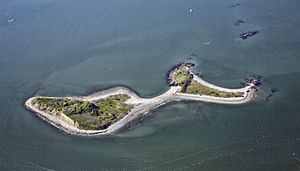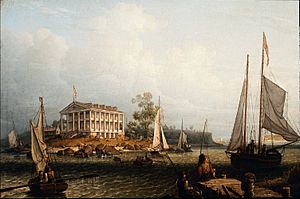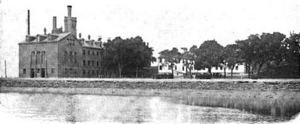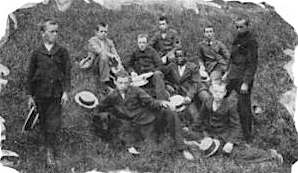Rainsford Island facts for kids
Rainsford Island is a small island in Boston Harbor. It is about 11 acres (45,000 m²) in size. The island is located between Long Island and Peddocks Island. It has also been known by other names like Hospital Island and Quarantine Island.
Rainsford Island has two small hills called drumlins. They reach about 49 feet (15 meters) above sea level. The island's edges are mostly rocky. There is a sandy area on the south side. Many different wildflowers grow there. You can only get to the island by private boat. Since 1996, it has been part of the Boston Harbor Islands National Recreation Area.
The Story of Rainsford Island
This island got its name from Edward Rainsford. He was one of the first European settlers known to live there. He might have been given rights to the island in 1636. He used it as a farm for cattle.
Native Americans used the island long ago. Later, during the time of the colonists, people lived and farmed there. From 1737 to 1925, Rainsford Island had many different uses. It was a hospital for people with diseases. It was also a burial ground for the sick and for criminals. The island served as a home for the poor and a hospital for soldiers. It was even a school for young people who needed guidance. At one point, it was a vacation spot. Today, only old building foundations and a broken seawall remain from these times.
In the early 1800s, the hospital buildings on Rainsford Island got bigger and better. A large building called the Stone Hospital was built in 1832. It was designed in a style called Greek Revival. This building might have been designed by Isaiah Rogers. He was a famous American architect. He designed important buildings like the U.S. Treasury Building.
In 1899, something exciting happened at the reformatory. A group of boys escaped from the island. They used stolen boats and even rafts they made themselves. Most of them were caught later.
The Island's Burial Ground
Rainsford Island was also a burial place for many people. At least 1,777 people were buried there between the 1730s and 1898. However, today there are no monuments or fences marking the cemetery. Most of the people buried there were poor. Others had died after being treated at the island's hospitals. Many were buried together in large graves. More than 100 soldiers from the Civil War are buried on the island. This includes at least one soldier from the brave 54th Massachusetts Regiment.






